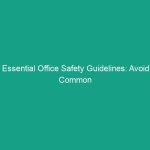Good Morning Team!
Today, we are going to discuss an incredibly important topic: Essential Guidelines to Prevent Occupational-related Cancer Risks. Understanding and mitigating these risks is not just about compliance; it’s about ensuring our health and Safety while we work. By the end of this Toolbox Talk, you will have a clearer understanding of how to protect yourself and your coworkers from potential Hazards that can lead to cancer.
Understanding Essential Guidelines to Prevent Occupational-related Cancer Risks
Occupational-related cancer risks refer to the Hazards in our work Environment that may increase our chances of developing cancer. These risks can stem from exposure to certain chemicals, prolonged exposure to radiation, physical work conditions, and even the ergonomic setup of our workspaces. It’s crucial to understand that these risks aren’t just theoretical; they can have real impacts on our health and well-being.
Many employees might think, “It won’t happen to me,” or “I’m not exposed to dangerous materials.” However, occupational cancer can develop over time and might not present symptoms until it’s too late. Awareness is our first line of defense.
Key Hazards, Risks, and Safety Considerations
Identifying the Hazards
There are several key hazards that can contribute to occupational-related cancer risks:
- Chemical Exposure: Many industries use chemicals that are known carcinogens, including asbestos, benzene, and formaldehyde.
- Radiation: Workers in certain fields may be exposed to ionizing radiation, which is a known risk factor for cancer.
- Repetitive Motion and Ergonomics: Poor posture and repetitive strain can lead to chronic conditions, and some studies suggest a link to certain types of cancer.
The consequences of ignoring these risks can be severe. For instance, prolonged exposure to carcinogens without proper protective measures can lead to long-term health issues, including various forms of cancer. It’s vital to stay informed and recognize these risks in our daily operations.
Best Practices, Procedures, & Actionable Advice
Safety Procedures to Follow
Here are essential guidelines and Best Practices to help mitigate occupational-related cancer risks:
- Use Personal Protective Equipment (PPE): Always wear the appropriate PPE for the task at hand. This might include gloves, masks, goggles, or full-body suits depending on exposure risks.
- Follow Safety Data Sheets (SDS): Familiarize yourself with the SDS for any chemicals you handle. This document provides crucial information about hazards and safety Precautions.
- Implement Good Housekeeping Practices: Keep your work area clean and organized to reduce the chance of exposure to harmful substances.
- Participate in Regular Training: Attend safety training sessions and stay updated on new safety protocols and practices.
- Report Unsafe Conditions: If you notice any unsafe conditions or practices, report them immediately to ensure swift action.
Real-Life Examples
Consider the case of a manufacturing plant where employees were exposed to high levels of a carcinogenic chemical without adequate ventilation or protective gear. Several workers later developed respiratory issues and were diagnosed with cancer. This situation highlights the critical need for strict adherence to safety protocols and the importance of a proactive safety culture.
Regulations, Standards, and Compliance
Understanding and complying with safety Regulations is fundamental in our efforts to prevent occupational-related cancer risks. Regulatory bodies such as OSHA (Occupational Safety and Health Administration) have established guidelines that require employers to manage hazards effectively.
Compliance with these regulations not only protects you as an employee but also safeguards the organization against legal repercussions and fines. It’s important to stay informed about these Standards and how they apply to your specific role and workplace environment.
Employee Engagement & Discussion
Let’s take a moment to engage in a discussion. Can anyone share experiences or challenges you’ve faced regarding Safety Measures against cancer risks in our workplace? What steps do you think we can improve upon to enhance our safety protocols?
Conclusion & Key Takeaways
In summary, preventing occupational-related cancer risks is a shared responsibility that requires awareness, proactive measures, and compliance with safety regulations. Remember the following key points:
- Understanding the hazards and risks associated with your work environment is crucial.
- Always use appropriate PPE and follow established safety procedures.
- Stay informed about safety regulations and participate actively in safety training.
- Engage with your coworkers to foster a culture of safety and openness.
Thank you for your attention and commitment to maintaining a safe workplace. Let’s prioritize our health and safety every day!


